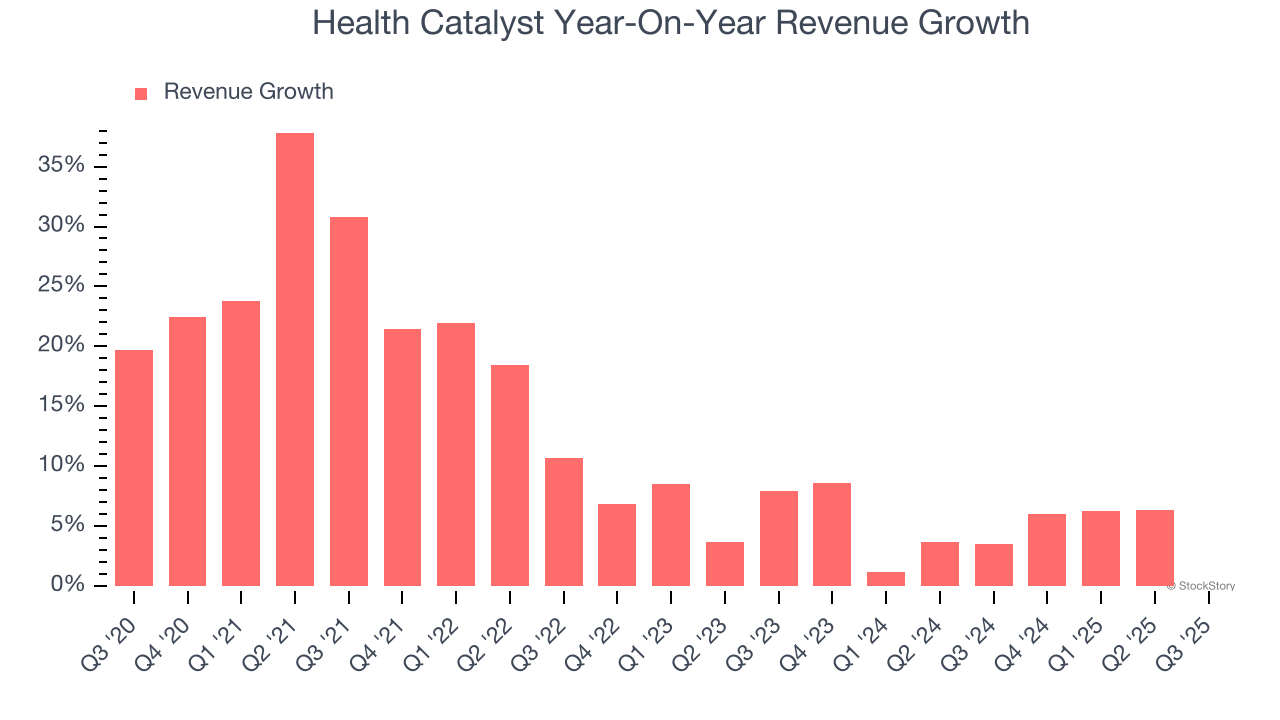
Healthcare data analytics company Health Catalyst (NASDAQ:HCAT) announced better-than-expected revenue in Q3 CY2025, but sales were flat year on year at $76.32 million. On the other hand, next quarter’s revenue guidance of $73.5 million was less impressive, coming in 1.7% below analysts’ estimates. Its non-GAAP profit of $0.06 per share was in line with analysts’ consensus estimates.
Is now the time to buy Health Catalyst? Find out by accessing our full research report, it’s free for active Edge members.
Health Catalyst (HCAT) Q3 CY2025 Highlights:
- Revenue: $76.32 million vs analyst estimates of $75.01 million (flat year on year, 1.7% beat)
- Adjusted EPS: $0.06 vs analyst estimates of $0.07 (in line)
- Adjusted EBITDA: $12 million vs analyst estimates of $10.39 million (15.7% margin, 15.5% beat)
- Revenue Guidance for Q4 CY2025 is $73.5 million at the midpoint, below analyst estimates of $74.81 million
- EBITDA guidance for the full year is $41 million at the midpoint, above analyst estimates of $40.24 million
- Operating Margin: -22.9%, down from -17.9% in the same quarter last year
- Free Cash Flow was -$5.27 million compared to -$14.19 million in the previous quarter
- Market Capitalization: $199.2 million
“For the third quarter of 2025, I am pleased by our financial results, including total revenue of $76.3 million and Adjusted EBITDA of $12.0 million, with these results beating our quarterly guidance on each measure,” said Dan Burton, CEO of Health Catalyst.
Company Overview
Built on its "Health Catalyst Flywheel" methodology that emphasizes measurable outcomes, Health Catalyst (NASDAQ:HCAT) provides data and analytics technology and services that help healthcare organizations manage their data and drive measurable clinical, financial, and operational improvements.
Revenue Growth
A company’s long-term sales performance is one signal of its overall quality. Any business can put up a good quarter or two, but many enduring ones grow for years. Over the last five years, Health Catalyst grew its sales at a 12% annual rate. Although this growth is acceptable on an absolute basis, it fell short of our standards for the software sector, which enjoys a number of secular tailwinds.

Long-term growth is the most important, but within software, a half-decade historical view may miss new innovations or demand cycles. Health Catalyst’s recent performance shows its demand has slowed as its annualized revenue growth of 4.4% over the last two years was below its five-year trend. 
This quarter, Health Catalyst’s $76.32 million of revenue was flat year on year but beat Wall Street’s estimates by 1.7%. Company management is currently guiding for a 7.7% year-on-year decline in sales next quarter.
Looking further ahead, sell-side analysts expect revenue to decline by 3.9% over the next 12 months, a deceleration versus the last two years. This projection is underwhelming and implies its products and services will see some demand headwinds.
Software is eating the world and there is virtually no industry left that has been untouched by it. That drives increasing demand for tools helping software developers do their jobs, whether it be monitoring critical cloud infrastructure, integrating audio and video functionality, or ensuring smooth content streaming. Click here to access a free report on our 3 favorite stocks to play this generational megatrend.
Customer Acquisition Efficiency
The customer acquisition cost (CAC) payback period represents the months required to recover the cost of acquiring a new customer. Essentially, it’s the break-even point for sales and marketing investments. A shorter CAC payback period is ideal, as it implies better returns on investment and business scalability.
Health Catalyst’s recent customer acquisition efforts haven’t yielded returns as its CAC payback period was negative this quarter, meaning its incremental sales and marketing investments outpaced its revenue. The company’s inefficiency indicates it operates in a highly competitive environment where there is little differentiation between Health Catalyst’s products and its peers.
Key Takeaways from Health Catalyst’s Q3 Results
We were impressed by how significantly Health Catalyst blew past analysts’ EBITDA expectations this quarter. We were also glad its full-year EBITDA guidance exceeded Wall Street’s estimates. On the other hand, its revenue guidance for next quarter missed and its EBITDA guidance for next quarter fell short of Wall Street’s estimates. Overall, this quarter could have been better. The stock traded up 1.6% to $2.90 immediately following the results.
Is Health Catalyst an attractive investment opportunity at the current price? When making that decision, it’s important to consider its valuation, business qualities, as well as what has happened in the latest quarter. We cover that in our actionable full research report which you can read here, it’s free for active Edge members.
